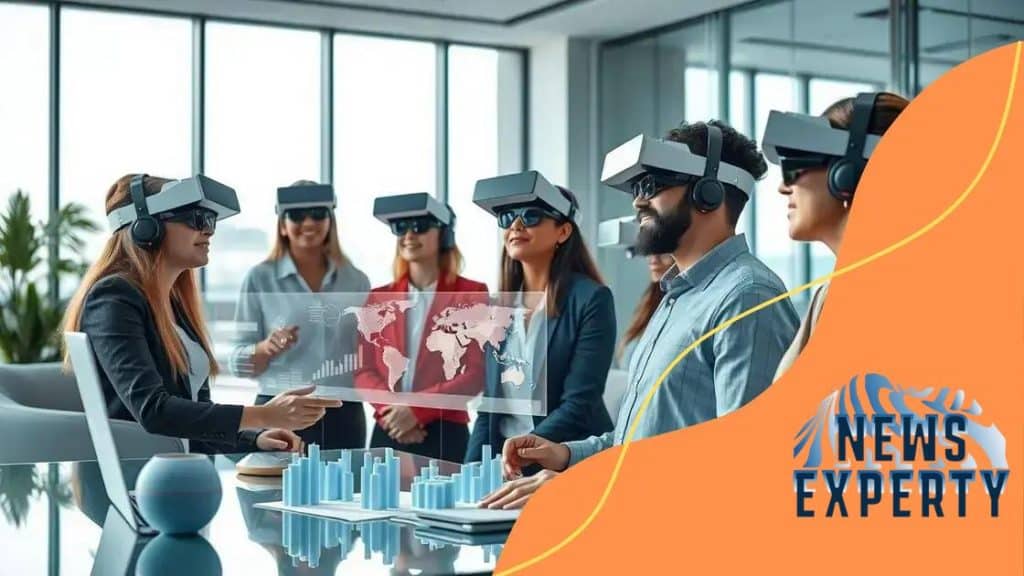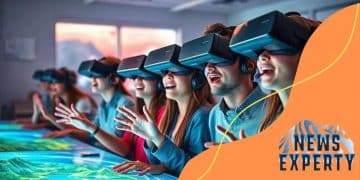How augmented reality is changing remote collaboration

Anúncios
Augmented reality is transforming remote collaboration by enhancing communication, providing immersive training experiences, and creating interactive virtual workspaces, despite challenges like cost and technical complexity.
How augmented reality is changing remote collaboration might just be the next big leap in how we work together. Ever wondered how this technology can reshape your meetings and teamwork dynamics? Let’s dive in!
Anúncios
Understanding augmented reality in the workplace
Understanding augmented reality (AR) in the workplace is crucial as it revolutionizes daily operations. This technology blends the digital and physical worlds, providing exciting possibilities for collaboration and efficiency.
What is augmented reality?
Augmented reality creates a live view of the real world enhanced by computer-generated content. This means users can interact with digital elements seamlessly. Think of it as adding a layer of information over what you see in your office or during virtual meetings.
Benefits of AR in the workplace
Augmented reality enhances productivity and teamwork. Here are some key benefits:
Anúncios
- Improves communication, allowing team members to visualize complex data together.
- Facilitates remote collaboration as if everyone is in the same room.
- Boosts training and skill development through immersive experiences.
- Streamlines workflows by providing real-time data access.
As more businesses adopt augmented reality, they discover new ways to work efficiently. For instance, imagine taking a virtual tour of a factory from your office desk. This capability can enhance understanding and decision-making.
Moreover, AR tools help bridge gaps in communication. They allow teams to share visual content, making discussions clearer and more engaging. For example, engineers can overlay schematics on machinery during maintenance, facilitating quicker problem-solving.
AR also provides training opportunities that were once impossible. Employees can learn hands-on skills in a risk-free environment. Using AR, they can simulate on-the-job scenarios that prepare them for real challenges.
Companies implementing AR find themselves ahead of the curve. They benefit from increased employee engagement and decreased training costs. Additionally, AR strengthens customer relations by providing clients with enhanced service experiences.
Understanding how AR can transform your workplace will open new avenues for innovation and growth. As this technology advances, its potential will only expand, changing the way we work forever.
Benefits of using augmented reality for collaboration
The benefits of using augmented reality for collaboration are transforming how teams work together. This technology provides unique tools that enhance interaction and productivity, making tasks more engaging and efficient.
Enhanced Communication
Augmented reality allows team members to share information visually. Instead of just talking about an idea, they can see it. For example, engineers can show a 3D model of a product while discussing its features. This visual aid improves understanding and reduces the chance of miscommunication.
Increased Engagement
Collaboration becomes more engaging with augmented reality. Users are more likely to participate when they interact with digital elements. This can lead to deeper discussions and innovative solutions. Teams can visualize data dynamically, making it easier to spot trends and anomalies.
- Interactive meetings boost morale.
- Visual tools encourage creative thinking.
- Teams feel connected, even when remote.
AR helps keep everyone on the same page. When team members can view and manipulate the same data, it fosters unity. This shared experience creates a sense of belonging, even in virtual environments.
Another advantage is the ability to conduct remote collaboration effectively. Team members can join from anywhere in the world and still feel involved. For instance, a designer can share a virtual prototype while a client offers feedback in real-time. This interaction speeds up the decision-making process.
Moreover, augmented reality accelerates problem-solving. With access to real-time data and visuals, teams can identify issues quickly and discuss them immediately. This agility is crucial in fast-paced environments, ensuring projects stay on track.
Overall, embracing augmented reality in collaboration opens up a world of possibilities. Teams can work more efficiently, creatively, and cohesively.
Real-world applications of augmented reality

Real-world applications of augmented reality are transforming various industries and enhancing everyday tasks. By integrating digital information with our physical surroundings, AR is making processes more efficient, engaging, and intuitive.
Healthcare Innovations
In healthcare, augmented reality is used to assist surgeons during complex procedures. By overlaying 3D images of organs or tissues onto a patient, doctors can visualize vital structures without making larger incisions. This technology increases accuracy and minimizes risks, leading to better patient outcomes.
Education Enhancements
In education, AR brings learning to life. Students can explore historical events or scientific concepts through immersive experiences. For example, they can see a 3D model of the solar system rotate in real-time, enhancing their understanding. This interactive approach keeps students engaged and can lead to better retention of information.
- Students can explore anatomy in detail through AR visualization.
- AR promotes collaborative learning experiences.
- Interactive quizzes enhance assessment methods.
Retail environments also benefit from augmented reality. Customers can try on clothes or visualize how furniture looks in their homes using AR apps. This technology allows them to make informed purchasing decisions without leaving their homes. As a result, retailers see increased customer satisfaction and reduced return rates.
In manufacturing, AR helps streamline production processes. Workers can access real-time data and instructions through AR glasses while assembling products. This reduces errors and increases efficiency. For instance, technicians can receive step-by-step guides displayed directly on the equipment they are working on.
Another exciting application is in tourism. Visitors can use AR apps to enhance their experiences at historical sites or museums. By pointing their devices at landmarks, they can view additional information, virtual reconstructions, or translations. This enriches their understanding and connects them more deeply to the surroundings.
The use of augmented reality continues to expand. As technology advances, the applications will become more widespread, offering innovative solutions that improve various aspects of our lives.
Challenges in adopting augmented reality tools
Challenges in adopting augmented reality tools can hinder their integration into workflows. While the benefits are significant, organizations often face obstacles that can slow down or complicate implementation.
Cost of Implementation
One major challenge is the cost associated with augmented reality technology. The initial investments for hardware, software, and training can be substantial, particularly for small businesses. This financial barrier can deter companies from exploring AR solutions.
Technical Complexity
The technical complexity of augmented reality systems is another hurdle. Developing and maintaining AR applications requires specialized skills and knowledge. Many organizations may not have the in-house expertise needed to manage these technologies effectively, leading to reliance on external vendors.
- Training staff can be time-consuming and costly.
- Integration with existing systems can be challenging.
- Regular updates and maintenance are required.
Moreover, some industries are not fully ready for the shift to AR. In environments where traditional methods are deeply entrenched, transitioning to digital tools can face resistance. Employees may feel overwhelmed or unsure about using new technology that alters their daily routines.
Another challenge involves ensuring user acceptance. It is crucial for organizations to provide adequate training and support to help users adapt to augmented reality. If the technology is perceived as too complicated or not user-friendly, employees may hesitate to embrace it.
Data privacy and security issues also play a significant role in adopting augmented reality tools. Organizations must consider how to safeguard sensitive information when implementing AR systems. Ensuring that data is protected from breaches during AR functionalities is essential for compliance with regulations.
Despite these challenges, many businesses are finding ways to overcome them. By carefully planning the integration of augmented reality and investing in user training, companies can maximize their chances of success and fully leverage the benefits associated with this emerging technology.
Future trends in remote collaboration with augmented reality
Future trends in remote collaboration with augmented reality are poised to reshape how teams interact and work together across distances. As technology advances, we can expect notable changes in the way collaborative work is conducted.
Increased Use of Virtual Workspaces
One significant trend is the rise of virtual workspaces. These spaces allow teams to gather in a digital environment where they can interact with 3D models and real-time data. Instead of traditional video conferencing, employees will engage in more immersive meetings that feel like they are in the same room. This will foster better collaboration and engagement.
More Interactive Training Solutions
Another exciting development is the integration of augmented reality in training programs. Companies will use AR to create realistic training simulations. For example, new employees can practice their skills in a safe virtual environment before handling real tasks. These immersive experiences will improve learning curves and retention.
- Customized training programs based on individual learning styles.
- Real-time feedback during training sessions.
- Reduced costs associated with physical training resources.
Additionally, as remote work continues to grow, so will the AR applications designed for collaboration. Tools that allow users to share and annotate documents in an AR format are becoming increasingly popular. This will enable teams to brainstorm more creatively, visualize complex issues, and develop solutions rapidly.
Privacy and security will also evolve with these new trends. Companies will invest in safer AR platforms to ensure sensitive information remains protected during collaboration. With a focus on data security, businesses can fully embrace the benefits of augmented reality without compromising their integrity.
Finally, we can expect an emphasis on user experience. Future AR tools will become more intuitive and user-friendly, making it easier for team members to adopt and utilize these technologies effectively. By simplifying the onboarding process, businesses can ensure smoother transitions into using AR for remote collaboration.
The future of remote collaboration will focus on enhancing user connections, improving training processes, and ensuring security while using augmented reality tools. Implementing these trends will drive productivity and innovation in the workforce.
In conclusion, augmented reality is set to revolutionize remote collaboration. As we’ve explored, this technology enhances communication, engagement, and training. Despite some challenges like cost and complexity, the benefits outweigh the drawbacks. Embracing AR tools leads to more productive and innovative workplaces. Companies that invest in these technologies will stay ahead in the competitive landscape, shaping the future of work.
\n\n\n
\n
\n
FAQ – Frequently Asked Questions about Augmented Reality in Remote Collaboration
What is augmented reality and how does it enhance collaboration?
Augmented reality (AR) overlays digital information in the real world, improving communication and engagement during remote meetings.
What are the training benefits of using augmented reality?
AR offers realistic training simulations that help employees learn faster and retain information better by engaging them in immersive experiences.
What challenges do businesses face when adopting AR technology?
Challenges include high implementation costs, technical complexity, and ensuring user acceptance during the transition to new tools.
How is augmented reality expected to evolve in the future?
The future will likely see more intuitive AR tools, increased focus on data security, and more interactive virtual workspaces to support remote collaboration.





